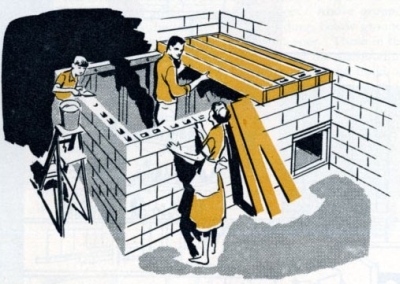Public bomb-survival training programs began in schools around the country and, though the effectiveness of the training was limited at best, were designed to relieve public fears.1 Hundreds of survival manuals of varying accuracy and usefulness, from both government and civilian sources, were published in the 1950s and '60s, leading to extensive criticism from the scientific community.234
In response to the less-useful publications, a number of civil and military engineers and strategists began practical research into defense against a nuclear strike. These experts agreed that there were two major components to survivability: fortification and dispersal. In order for the U.S. to survive a nuclear attack with minimal damage, targets needed both to be reinforced against shock and isolated from other priority strike zones and civilian population centers. This strategy served a dual purpose by reducing damage and forcing the aggressor to use greater numbers of warheads.
Extensive studies were conducted on the construction of bomb shelters and fortified buildings as well as the development of effective damage-control techniques such as firefighting and emergency medical treatment.567 Ultimately, many of the suggested survival plans demanded vast construction programs, access to millions of tons of steel and concrete, and the relocation of hundreds of thousands of civilians and military personnel.
Though several defense options were indeed inhibited by cost and practicality, the U.S. did disperse major weapons stockpiles to remote locations to reduce the chance of incidental civilian death. In 1962, at the height of its nuclear might, the United States possessed 25,540 warheads in silos and storage facilities around the country. Additionally, many public buildings such as courthouses and schools were fortified to withstand certain levels of shock. Civilians also engaged in the construction of homemade bomb shelters, a practice widely regarded today as futile.8 Volunteer fire brigades, public officials, and military personnel likewise underwent disaster preparedness training tailored specifically to nuclear attack response.9
Despite decades of tension and years of ideology-driven violence in Asia, no hostile nuclear weapons were ever launched against either country. The Cold War ended in 1991 with the fall of the Soviet Union, effectively ending America's fear of nuclear annihilation.

